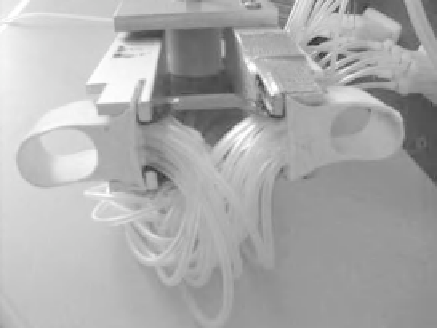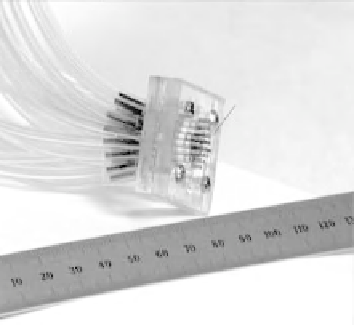Biomedical Engineering Reference
In-Depth Information
Stimulator
pins
Figure 7.14
Pneumatic tactile display
replaced by a resistor or another semiconductor device. The main application of the
thermal tactile display is in Braille cells [45].
7.3.8 Pneumatic Tactile Displays (Shape)
To provide local shape information, an array of force generators can create a pressure
distribution on a fingertip, thereby synthesizing an approximate true contact. Researchers
at the University of Berkley [46, 47] have developed a prototype of a 5
×
5 tactile
interface actuated by pneumatic technology with 3 bits of resolution. The pneumatic
prototype interface delivers up to 0.3 N per actuator. This tactile display, which is similar
to a servomotor tactile display, has certain advantages, such as ease of fabrication and no
pin friction. Figure 7.14 shows the pin array and the molding which covers the pins.
7.3.9 Electrocutaneous Tactile Displays
An electrocutaneous display is a tactile device that directly activates nerve fibers within
the skin with electrical current from surface electrodes (Figure 7.15), thereby generating
sensations of pressure or vibration without the use of any mechanical actuator [16, 48-50].
It is known that the nerves connected to the tactile receptors can be stimulated selectively
by electrostimulation to some extent. Meissner's corpuscles, which detect the dynamic
deformation of a finger, can be stimulated by anode current, while Merkel's disks, which
detect static deformation, can be stimulated by cathode current [51, 52].
7.3.10 Other Tactile Display Technologies
Other technologies have been used to develop tactile displays, including:
•
Producing tactile sensation with acoustic radiation pressure [53].
•
Tactile glove that exhibits pressure and temperature feedback, called Teletact [54].
•
Effect of linear combination of magnets on the skin [55].


